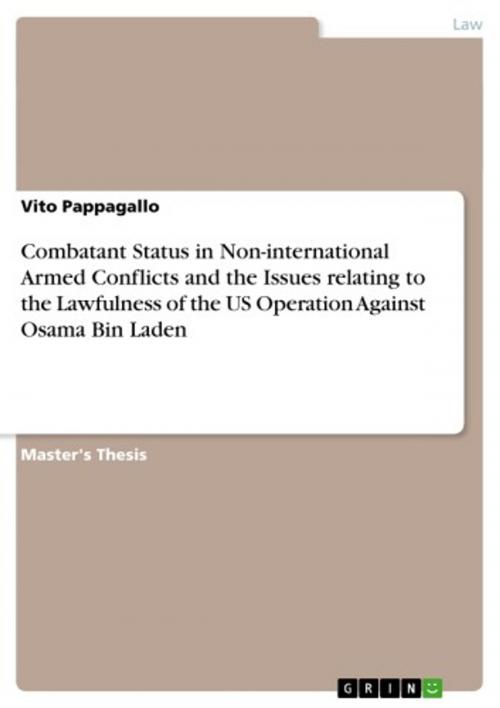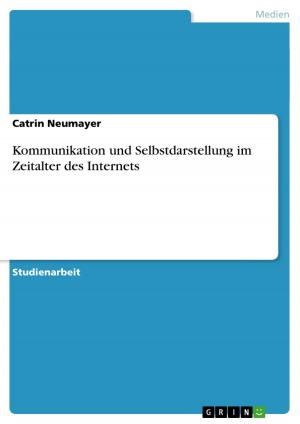Combatant Status in Non-international Armed Conflicts and the Issues relating to the Lawfulness of the US Operation Against Osama Bin Laden
Nonfiction, Reference & Language, Law, International| Author: | Vito Pappagallo | ISBN: | 9783656028482 |
| Publisher: | GRIN Verlag | Publication: | October 14, 2011 |
| Imprint: | GRIN Verlag | Language: | English |
| Author: | Vito Pappagallo |
| ISBN: | 9783656028482 |
| Publisher: | GRIN Verlag |
| Publication: | October 14, 2011 |
| Imprint: | GRIN Verlag |
| Language: | English |
Master's Thesis from the year 2011 in the subject Law - European and International Law, Intellectual Properties, grade: Distinction, University of Westminster, course: International Humanitarian Law, language: English, abstract: This study takes into account the important changes concerning the way to conduct armed conflicts that has been made over the last century. One of the most important changes concerns the types of armed conflicts. Nowadays, the term 'war' and the phrase 'civil war' have been replaced by the phrases, 'international' and 'non-international' armed conflicts, respectively. In the following pages of this study, since the end of the Second World War, an important raise in the numbers of non-international armed conflicts was registered around the world. Despite this, most of the treaties, conventions and regulations concerned the conduct of international armed conflict, even if these armed conflicts were very uncommon. Taking into account this important change, the International Criminal Tribunal for the Former Yugoslavia (hereinafter ICTY) in a Tadi? case suggested that the law of armed conflict should be applied more uniformly. According to the Court orientation, the equal application of the law of armed conflicts is justified by the exponential growing frequency and cruelty of internal conflicts which make irrelevant the distinction between types of armed conflicts. The same conclusion has been reached by the International Committee of the Red Cross (hereinafter ICRC) through its study on the international customary status of international humanitarian law, by which has been proved that there are tangibles reasons in order to support the abandon of the legal distinction between the international and non-international armed conflicts. As it will be demonstrated in the first chapter of this study, the progress made by the international community in this sense has been considerable. Indeed, it can be said that, nowadays, there is an important body of provisions concerning the law of international armed conflicts which applied also to a non-international armed conflicts. However, some distinct areas regulated by the law of armed conflicts, such as combatant status and prisoners of war rights, remain exclusive to international armed conflicts. The second chapter of this study, therefore, will explore the meaning of combatant status and the reasons of its denial to non-State participants during an non-international armed conflict. Consequently, it will be discussed the status of non-State participants when no longer engaged in non-international armed conflict and analysed the legality of the Osama Bin Laden killing in accordance with the law of armed conflicts.
Master's Thesis from the year 2011 in the subject Law - European and International Law, Intellectual Properties, grade: Distinction, University of Westminster, course: International Humanitarian Law, language: English, abstract: This study takes into account the important changes concerning the way to conduct armed conflicts that has been made over the last century. One of the most important changes concerns the types of armed conflicts. Nowadays, the term 'war' and the phrase 'civil war' have been replaced by the phrases, 'international' and 'non-international' armed conflicts, respectively. In the following pages of this study, since the end of the Second World War, an important raise in the numbers of non-international armed conflicts was registered around the world. Despite this, most of the treaties, conventions and regulations concerned the conduct of international armed conflict, even if these armed conflicts were very uncommon. Taking into account this important change, the International Criminal Tribunal for the Former Yugoslavia (hereinafter ICTY) in a Tadi? case suggested that the law of armed conflict should be applied more uniformly. According to the Court orientation, the equal application of the law of armed conflicts is justified by the exponential growing frequency and cruelty of internal conflicts which make irrelevant the distinction between types of armed conflicts. The same conclusion has been reached by the International Committee of the Red Cross (hereinafter ICRC) through its study on the international customary status of international humanitarian law, by which has been proved that there are tangibles reasons in order to support the abandon of the legal distinction between the international and non-international armed conflicts. As it will be demonstrated in the first chapter of this study, the progress made by the international community in this sense has been considerable. Indeed, it can be said that, nowadays, there is an important body of provisions concerning the law of international armed conflicts which applied also to a non-international armed conflicts. However, some distinct areas regulated by the law of armed conflicts, such as combatant status and prisoners of war rights, remain exclusive to international armed conflicts. The second chapter of this study, therefore, will explore the meaning of combatant status and the reasons of its denial to non-State participants during an non-international armed conflict. Consequently, it will be discussed the status of non-State participants when no longer engaged in non-international armed conflict and analysed the legality of the Osama Bin Laden killing in accordance with the law of armed conflicts.















